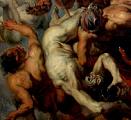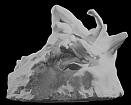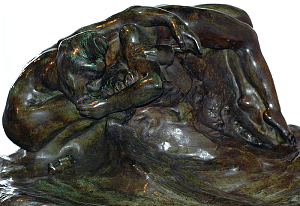|
 'The
Fallen
Angel' is one example of Rodin's typical use of the technique of marcottage - the construction of figures or groups from pre-existing
elements. 'The
Fallen
Angel' is one example of Rodin's typical use of the technique of marcottage - the construction of figures or groups from pre-existing
elements.
Around 1895, Rodin produced this combination
of 'The Caryatid' with the
female figure of 'Eternal
Springtime', which was in turn derived from 'Torso
of Adèle', the female version of the twin Triton torsos Rodin designed
for the Villa Neptune in Nice in 1879.
 Like
for 'Christ and Mary Magdalene', we can discern
different strands of meaning: Like
for 'Christ and Mary Magdalene', we can discern
different strands of meaning:
'Chûte des anges', the fall of the rebellious angels led by
Lucifer was a motif presented by many Christian artists. The Cleveland Museum,
Ohio, owns a marble group by Rodin actually called 'The Fall of the Angels'
[Spear, 1967, Plate 88].
In 'The Fallen Angel', Rodin has switched from plural to singular, and so
changes the emotional impact of the composition: this gentle winged
creature, separated from Lucifer's crowd, looks virginlike,
innocent, as if dropped from heaven by some regrettable accident.
Whereas Breughel and Rubens depict their fallen angels as if  they had been satanic creatures from the very start, Rodin's 'Fallen
Angel' commands our admiration by her celestial beauty and languid sensuality.
After his early confrontation with Father Eymard,
who refused to accept the bust Rodin had made of him, the sulptor had
they had been satanic creatures from the very start, Rodin's 'Fallen
Angel' commands our admiration by her celestial beauty and languid sensuality.
After his early confrontation with Father Eymard,
who refused to accept the bust Rodin had made of him, the sulptor had been very
sceptical of Catholic beliefs;
like Charles Baudelaire, Octave Mirbeau
and Félicien Rops, he was rather enthrilled by the eternally restless powers of evil,
mysterious, seductive and dangerous - like 'The Sin' portrayed by Franz von Stuck,
the sensation at the exhibition of the Munich Secession in 1893.
In 'Fallen Angel', though, the veil of darkness is replaced by the
exuberant flow of blonde hair and the translucent quality of white marble. Like in 'The Kiss', where a nude Francesca took over the active role
traditionally assigned to Paolo, Rodin in this work ignores moralistic and literary
default settings in order to immerse himself in the soft splendour of lines and
light. been very
sceptical of Catholic beliefs;
like Charles Baudelaire, Octave Mirbeau
and Félicien Rops, he was rather enthrilled by the eternally restless powers of evil,
mysterious, seductive and dangerous - like 'The Sin' portrayed by Franz von Stuck,
the sensation at the exhibition of the Munich Secession in 1893.
In 'Fallen Angel', though, the veil of darkness is replaced by the
exuberant flow of blonde hair and the translucent quality of white marble. Like in 'The Kiss', where a nude Francesca took over the active role
traditionally assigned to Paolo, Rodin in this work ignores moralistic and literary
default settings in order to immerse himself in the soft splendour of lines and
light.
The later titles 'Illusions received by the Earth' and 'The Fall of
Icarus' evidently imply an association with 'The
Fall of Illusion, Sister of Icarus', in another version equally named 'The
Fall of Icarus', featuring the winged 'Martyr'.
This connection confirms 'The Fallen Angel' deals with failed revolt,
sympathising with the courage to try and realise grand ideals, even when
this quest proves to be based on illusion.
In Rodin's
assemblage of a crouching with a reclining figure, the caressing embrace
provides the element of consolation, denied to his isolated
winged 'Martyr' in 'Fall of Icarus' and
his lonely 'Prodigal Son' (1886), but
movingly present in 'Christ and Mary
Magadalene', created around 1893-94 and executed in marble as well.
 As
has been amply discussed with regard to 'Christ and Mary
Magdalen', Rodin had to swallow a series
of serious setbacks during the 1890's: the rejection of his 'Monument to Victor Hugo'
in 1890, the vehement critique of his Monument to Claude Lorraine in Nancy in June
1892, the flaring crisis in his relationships with Rose and
Camille ,
a dissatifying installation of 'The Burghers of
Calais' in 1895. The rejection of his 'Balzac' in
1898 was only the summit of a longer series of bitter disappointments. To the
sculptor, adopting the role of the misunderstood genius, creating both 'Christ and Mary Magdalene' and 'Illusion, received by the Earth'
must have meant comfort to his hurt feelings. As
has been amply discussed with regard to 'Christ and Mary
Magdalen', Rodin had to swallow a series
of serious setbacks during the 1890's: the rejection of his 'Monument to Victor Hugo'
in 1890, the vehement critique of his Monument to Claude Lorraine in Nancy in June
1892, the flaring crisis in his relationships with Rose and
Camille ,
a dissatifying installation of 'The Burghers of
Calais' in 1895. The rejection of his 'Balzac' in
1898 was only the summit of a longer series of bitter disappointments. To the
sculptor, adopting the role of the misunderstood genius, creating both 'Christ and Mary Magdalene' and 'Illusion, received by the Earth'
must have meant comfort to his hurt feelings.
If we abstract from religious,
mythological/allegorical and auto-biographical associations, the group
shows the bodies of two women intimately entwined, as already explored in 'Damned women',
in several variations
and under different names, like 'The Metamorphoses of Ovid', 'Bacchantes
embracing', etc.
Such titles
made these representations more acceptable to the public, so that Michelle Facos
with regard to 'The Fallen Angel' speaks of a "crypto-lesbian theme". We will find this subject again in Rodin's
later erotic drawings, this time without any mythological or literary
pretext.
 After unwinged bronze casts had
been made from earlier plaster versions, the composition was adapted again
and executed in
marble. According to Elsen, it
was only at this stage that the wings were added, while the base was enlarged so
that the legs of the angel would meet structural support. Referring to the
example in Lille, Daniel Rosenfeld describes
how Rodin's praticiens left parts of the
marble block with a roughened surface while the figures were polished
in Fin-de-Siècle manner; different types of chisels were employed
to reach
the desired effect. After unwinged bronze casts had
been made from earlier plaster versions, the composition was adapted again
and executed in
marble. According to Elsen, it
was only at this stage that the wings were added, while the base was enlarged so
that the legs of the angel would meet structural support. Referring to the
example in Lille, Daniel Rosenfeld describes
how Rodin's praticiens left parts of the
marble block with a roughened surface while the figures were polished
in Fin-de-Siècle manner; different types of chisels were employed
to reach
the desired effect.
Based
on these successful marble carvings, presenting the group - originally a marcottage
- as if made 'in one piece', new bronze casts were made
by the Alexis Rudier Foundry. At least one bronze cast was derived from a marble
carving that - according to Elsen - was made for the Hunterian Art Gallery.
 The
main difference between these versions is the way the crouching woman
holds the fallen figure with her left hand. Whereas in all copies, the
right hand of the supporting character fixes the recumbent figure at her
armpit (just like in 'Eternal
Springtime'), the left arm is reaching across the bossom in the
Stanford and Aix-les-bains bronzes, whereas in the Lille marble carving, this left arm remains folded behind the other figure.
The latter seems to be the most recent version; the Musée Rodin owns
marble carvings in both versions. The
main difference between these versions is the way the crouching woman
holds the fallen figure with her left hand. Whereas in all copies, the
right hand of the supporting character fixes the recumbent figure at her
armpit (just like in 'Eternal
Springtime'), the left arm is reaching across the bossom in the
Stanford and Aix-les-bains bronzes, whereas in the Lille marble carving, this left arm remains folded behind the other figure.
The latter seems to be the most recent version; the Musée Rodin owns
marble carvings in both versions.
|


 they had been satanic creatures from the very start, Rodin's 'Fallen
Angel' commands our admiration by her celestial beauty and languid sensuality.
After his early confrontation with
they had been satanic creatures from the very start, Rodin's 'Fallen
Angel' commands our admiration by her celestial beauty and languid sensuality.
After his early confrontation with  been very
sceptical of Catholic beliefs;
like Charles Baudelaire, Octave Mirbeau
and Félicien Rops, he was rather enthrilled by the eternally restless powers of evil,
mysterious, seductive and dangerous - like 'The Sin' portrayed by Franz von Stuck,
the sensation at the exhibition of the Munich Secession in 1893.
In 'Fallen Angel', though, the veil of darkness is replaced by the
exuberant flow of blonde hair and the translucent quality of white marble. Like in
been very
sceptical of Catholic beliefs;
like Charles Baudelaire, Octave Mirbeau
and Félicien Rops, he was rather enthrilled by the eternally restless powers of evil,
mysterious, seductive and dangerous - like 'The Sin' portrayed by Franz von Stuck,
the sensation at the exhibition of the Munich Secession in 1893.
In 'Fallen Angel', though, the veil of darkness is replaced by the
exuberant flow of blonde hair and the translucent quality of white marble. Like in 
 After unwinged bronze casts had
been made from earlier plaster versions, the composition was adapted again
and executed in
marble. According to Elsen, it
was only at this stage that the wings were added, while the base was enlarged so
that the legs of the angel would meet structural support. Referring to the
example in Lille, Daniel Rosenfeld describes
how Rodin's praticiens left parts of the
marble block with a roughened surface while the figures were polished
in Fin-de-Siècle manner; different types of chisels were employed
to reach
the desired effect.
After unwinged bronze casts had
been made from earlier plaster versions, the composition was adapted again
and executed in
marble. According to Elsen, it
was only at this stage that the wings were added, while the base was enlarged so
that the legs of the angel would meet structural support. Referring to the
example in Lille, Daniel Rosenfeld describes
how Rodin's praticiens left parts of the
marble block with a roughened surface while the figures were polished
in Fin-de-Siècle manner; different types of chisels were employed
to reach
the desired effect.
